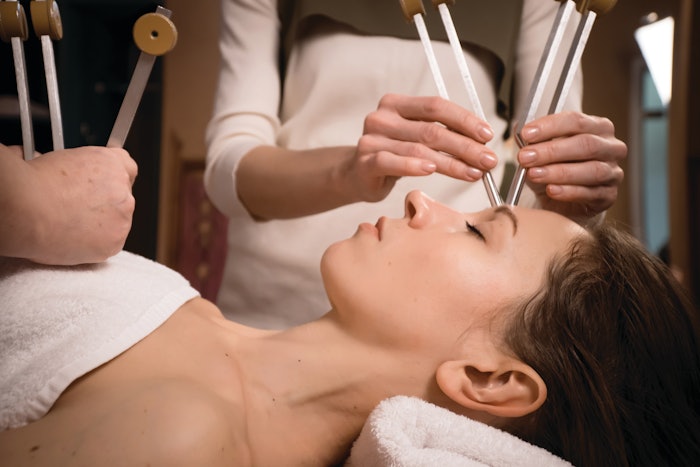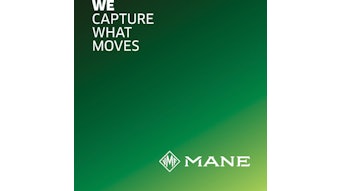
Sound therapy is providing major wellness benefits, and we're listening! We chatted with top experts in the field on what you should know about this popular practice.
Log in to view the full article
Sound therapy is providing major wellness benefits, and we're listening! We chatted with top experts in the field on what you should know about this popular practice.
What are the wellness benefits of sound therapy?
Brenda Molloy, owner & instructor, Studio Chi | School of the Healing Arts: Whether listening to sound or feeling its vibration, sound relaxes and nourishes our body, mind and soul. The cells and tissues of the body are encouraged to relax and release tension and pain. Our mind settles and it let’s go of what no longer serves us (old memories, traumas and beliefs). Our soul rejoices as it remembers its connection with Source, however we perceive it to be.
Cruz Kim, director of massage, Burke Williams Spa: Sound therapy is non-invasive and scientifically based, utilizing vibrations and frequencies to affect the physical space. It can temporarily rearrange cells, aiding in muscle relaxation and enhancing massage therapy. Additionally, it helps the brain shift between Theta and Delta waves, promoting deep relaxation and mental clarity.
Kristen Johnson, MSN-ED, MAPP, RN. LE. CTP, CHEP: Sound therapy helps us connect with our senses, grounding us in the present moment. This practice benefits patients and providers alike, offering the ideal opportunity for full immersion into the spa experience. Patients achieve deeper relaxation, while providers focus on the immersive experience.
What trends are you seeing within sound therapy?
Molloy: More and more people are seeking sound therapy. Some choose to listen to the generous tones of the healing bowls or drums that encourage one to travel within. Others enjoy the precision of tuning forks applied to the body, face or in the auric fields. We can chant and sing to raise our vibration. Mindfully watching our thoughts and transforming them into positive thoughts is also a form of sound therapy.
Kim: Sound baths and sound bathing combined with breathwork are emerging trends. Traditional tools like tuning forks and gongs have been used for years, but remain underappreciated. Ultrasound is commonly used by chiropractors.
Related: Why Clients Are Loving Sound Therapy
How can spa pros incorporate sound therapy into their spa services?
Kate Morrison, director of wellness & sustainability, Spa Ojai: At the Ojai Valley Inn, a small group of intuitive massage therapists worked together to create an experience exclusive to Spa Ojai called Sound Energy Therapy. Using an eclectic combination of tools and instruments, including crystal and tibetan singing bowls, windchimes and native american vibrational wands, the therapist curates a unique treatment using sound and vibration to deliver a deep relaxation. Enhanced by cranial sacral techniques and reiki, this meditative service is grounding and represents the spiritual nature of Ojai.
Molloy: Sound therapy can be easily and gracefully incorporated into any spa service. It could be a little thing like striking a healing bowl with intention at the beginning and end of the service. Or the spa could offer Tuning Fork Facials as a service. Tuning Fork Facials utilize the acupoints and meridians on the face and neck to gently lift the face. This service also clears the sense organs, frees the mind, and releases creative blocks and brain fog. Tuning Fork Facials can be a full service or an add-on.
Kim: Spa professionals can use tuning forks, sound bowls, and music therapy, along with hands-on massage. Humming or singing, despite sounding unconventional, can positively affect the Vagus nerve, especially when combined with breathwork and lymphatic massage. Our practice is creative and artistic, Massage therapists can get creative exploring with various sound devices and techniques blended with hands-on therapy to achieve new results and create new techniques. If done well, this will help them stand out in a potentially saturated market.
What are your preferred sound therapy tools?
Molloy: It’s hard to choose a preferred sound therapy tool. They each have their special purpose. However, if I had to choose just one it would be tuning forks because I am able to apply them directly to the acupoints or area of concern, as well as enjoy their healing tones. The different frequencies of the tuning forks encourages the being to access specific information within to assist with their personal healing journey.
Kim: I prefer using sound bowls, breathwork, and humming, which consistently yield positive feedback from guests.
Johnson: I enjoy working with an array of tools, including gongs, tuning forks, tingshas and singing bowls.









